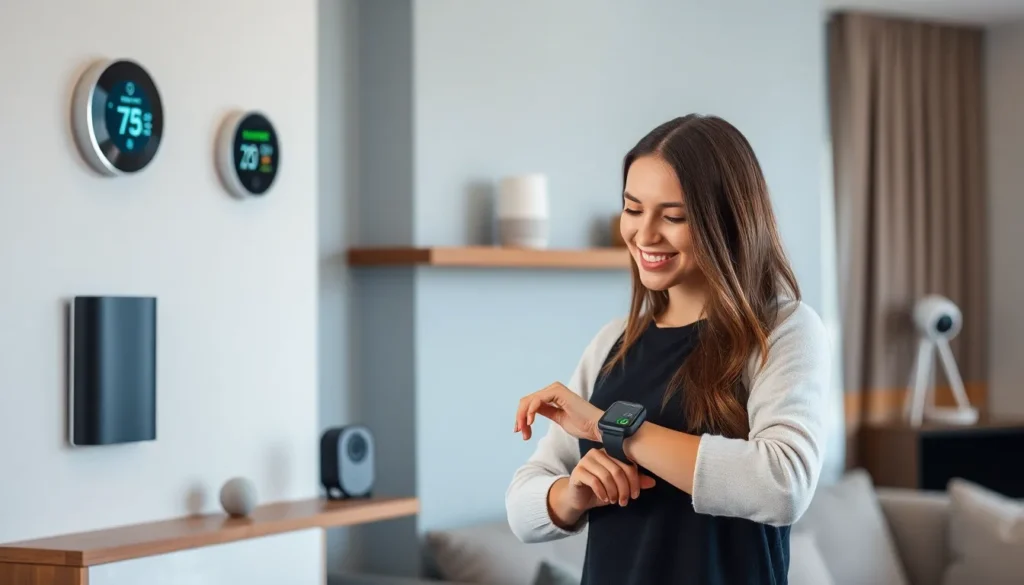In today’s fast-paced world, technology isn’t just a luxury; it’s practically a necessity. From the moment the alarm clock blares (thanks to your smartphone, of course) to the instant you binge-watch your favorite show, tech weaves itself into the fabric of daily life. It’s like that friend who shows up uninvited but somehow makes everything more interesting.
Table of Contents
ToggleOverview of Technology’s Impact
Technology shapes daily life through various applications, enhancing convenience and efficiency. Communication becomes instant with smartphones and messaging apps. Users connect with family and friends across distances, making relationships stronger. Additionally, navigation is streamlined with GPS systems. People easily find directions and explore new places without stress.
Health monitoring benefits from wearable technology. Devices track fitness levels and important health metrics, promoting better lifestyles. Online shopping also revolutionizes retail, allowing consumers to purchase items with a few taps. Shopping becomes more accessible, saving time for busy individuals.
Education evolves with digital platforms. Students access a wealth of information online, improving learning opportunities. Remote work gains popularity due to technological advancements. Employees collaborate effectively from various locations, reducing commute times.
Entertainment shifts with streaming services. Viewers enjoy countless movies and shows on demand, creating personalized experiences. Home automation enhances comfort and efficiency. Smart home devices control lighting and temperature, making living spaces more enjoyable.
Financial transactions transform through mobile banking. Individuals manage their finances conveniently from smartphones, enhancing financial literacy. Social media platforms influence daily interactions. Users share experiences and stay informed about trends through these channels.
These examples illustrate technology’s profound impact on various aspects of life. Integration into daily routines highlights its role as a fundamental part of modern existence.
Daily Communication
Technology revolutionizes daily communication, making it easier and faster than ever. Instant messaging and video calls play crucial roles in how people connect with each other.
Instant Messaging
Instant messaging apps like WhatsApp and Facebook Messenger transform conversations. Users send texts, photos, and videos instantly, fostering real-time interactions. Emojis and GIFs enrich exchanges, adding personality to chats. Group chats support discussions among multiple people, keeping families and friends connected. Notifications ensure that important messages don’t go unnoticed, making communication efficient.
Video Calls
Video calls through platforms like Zoom or Skype enhance face-to-face interactions. People use these services to maintain personal and professional relationships, regardless of distance. High-definition video quality brings interactions to life, making conversations more engaging. Screen sharing features facilitate collaboration during virtual meetings or family gatherings. This technology allows individuals to share experiences and stay connected, bridging geographical gaps effectively.
Smart Home Devices
Smart home devices integrate technology into everyday living, offering convenience, comfort, and enhanced security. These devices turn a regular household into a modern haven, streamlining daily tasks and improving quality of life.
Home Automation
Home automation systems control various functions like lighting, temperature, and appliances. Smart thermostats adjust heating and cooling based on user preferences, promoting energy efficiency. Automated lighting systems provide customizable settings for different times of the day or special occasions. Voice assistants like Amazon Alexa or Google Assistant allow users to manage devices hands-free. Smart TVs enable streaming and connectivity to other devices, enhancing the entertainment experience. These innovations not only simplify tasks but also contribute to creating a personalized living environment.
Security Systems
Security systems take advantage of advanced technology to provide robust safety features. Smart cameras and doorbell cameras allow homeowners to monitor their property in real-time through mobile apps. Motion sensors detect unusual activity and send alerts to users immediately. Smart locks enable keyless entry, increasing convenience while maintaining security. Integrated alarm systems provide peace of mind by alerting homeowners and authorities in emergencies. These systems offer comprehensive protection, demonstrating how technology plays a crucial role in safeguarding homes.
Health and Fitness Tracking
Technology significantly enhances health and fitness tracking in everyday life. Wearable devices and mobile health applications deliver users useful insights into their well-being.
Wearable Devices
Smartwatches and fitness trackers monitor physical activity levels, heart rates, and sleep quality. Many individuals rely on these devices to set fitness goals and track progress. Features like reminder notifications encourage users to stay active throughout the day. Sensors collect data, helping people understand their body patterns better. In 2022, approximately 45% of adults in the U.S. owned a wearable device, reflecting a growing trend in personal health management.
Mobile Health Applications
Mobile health applications offer diverse functionalities to users. These apps track nutrition, exercise, and mental health, providing personalized recommendations. Users can log meals and workouts, making it easier to adhere to health goals. Many applications further incorporate reminders for medication and hydration. In fact, studies show that health app usage improved patient engagement by 67%. Engaging with these apps aids individuals in making informed lifestyle choices and achieving wellness objectives.
Education and Learning
Technology revolutionizes education by offering innovative tools that enhance learning experiences. Students access vast resources, fostering independent learning and collaboration.
E-Learning Platforms
E-learning platforms provide flexible learning experiences, connecting students and instructors worldwide. They enable users to participate in courses from anywhere at any time. Platforms like Coursera and Udemy offer diverse subjects, ranging from computer science to photography. Over 170 million learners have enrolled in courses offered by these platforms, which also allow learners to earn certifications that enhance career prospects. Real-time interaction through discussion forums creates a sense of community among peers, encouraging knowledge sharing.
Educational Apps
Educational apps serve as effective learning aids, delivering interactive content directly to users’ devices. These apps engage students with gamified features that simplify complex concepts. Popular examples include Duolingo for language learning and Khan Academy for diverse academic subjects. Data shows that users spend an average of 19 hours per month on educational apps, enhancing retention through consistent practice. Teachers also integrate these applications into their classrooms, reinforcing lessons with supplemental materials. Students can access quizzes, videos, and exercises tailored to their skill levels, making learning more personalized.
Transportation and Navigation
Technology significantly impacts transportation and navigation, enhancing travel efficiency and convenience in daily life.
Ride-Sharing Services
Ride-sharing services like Uber and Lyft transformed how people get around. Individuals easily book rides through mobile apps, eliminating the need for traditional taxis. These services connect drivers and passengers, promoting quick pickups in urban areas. With options such as shared rides or luxury vehicles, users can select services that suit their budget and needs. In 2021, Uber reported facilitating over 6.3 billion rides globally. Such services have made commuting more affordable and accessible, reshaping urban transportation landscapes.
GPS Navigation
GPS navigation has revolutionized how individuals find their way. GPS systems provide real-time directions and traffic updates, ensuring drivers avoid congestion. Mobile navigation apps like Google Maps and Waze assist in planning trips, offering alternative routes to save time. According to a study, approximately 80% of smartphone users rely on GPS apps for navigation. These technologies enable walkers, cyclists, and drivers to navigate unfamiliar areas with confidence. By integrating voice commands, GPS navigation enhances safety while minimizing distractions during travel.
Finances and Banking
Technology has fundamentally transformed how individuals manage their finances and banking services. With modern solutions, users experience improved convenience and security in everyday transactions.
Online Banking
Online banking enables users to conduct transactions from anywhere at any time. Most banks offer mobile websites and apps for easy access to accounts and services. Individuals can quickly check balances, transfer funds, and pay bills, enhancing financial management. A survey indicated over 70% of Americans utilize online banking, affirming its popularity. Security features like two-factor authentication protect sensitive information, fostering trust among users. These advancements simplify banking while minimizing the need for physical visits to branches.
Mobile Payment Solutions
Mobile payment solutions, such as Apple Pay and Google Pay, have revolutionized how people make purchases. With these platforms, transactions occur within seconds using smartphones or smartwatches. Statistics reveal that around 43% of U.S. consumers prefer mobile payments over traditional methods. Users appreciate the contactless feature, improving convenience and hygiene during purchases. Additionally, loyalty programs integrated into mobile payment apps offer rewards and discounts, further encouraging adoption. As more merchants accept these payment options, their popularity continues to rise, shaping the future of consumer transactions.
Entertainment and Media Consumption
Technology shapes entertainment and media consumption, influencing how individuals access and enjoy content daily.
Streaming Services
Streaming services dominate the entertainment landscape, providing vast libraries of movies and shows. Platforms like Netflix, Hulu, and Amazon Prime Video allow subscribers to watch content on demand, with over 230 million global subscribers reported in 2023. Accessibility ensures viewers can enjoy their favorite programs anytime, anywhere, using various devices like smartphones, tablets, and smart TVs. Personalized recommendations enhance the viewing experience, adapting to user preferences based on viewing habits. Original content production has surged with these services investing billions in new films and series, reshaping the traditional entertainment industry. The convenience of binge-watching popular series drives viewer engagement, transforming how people consume film and television.
Social Media
Social media platforms play a crucial role in media consumption today as users engage with various forms of content. Platforms like Facebook, Instagram, and TikTok boast billions of active users, facilitating instant sharing of videos, articles, and live events. Influencers and creators generate unique content, fostering communities and driving trends in entertainment. User-generated content significantly influences how information spreads, allowing individuals to share experiences in real-time. Engagement metrics, such as likes and shares, help shape content popularity, impacting what users see daily. The fusion of entertainment and social media changes how audiences connect, making interaction an integral part of the media experience.
Technology has woven itself into the fabric of everyday life. Its presence is undeniable and its impact profound. From enhancing communication to revolutionizing education and health management, technology streamlines tasks and enriches experiences.
As it continues to evolve, individuals will likely find even more innovative applications that improve daily routines. Embracing these advancements not only fosters convenience but also enhances overall quality of life. The journey into a more connected and efficient future is just beginning, and technology will undoubtedly play a pivotal role in shaping what lies ahead.









